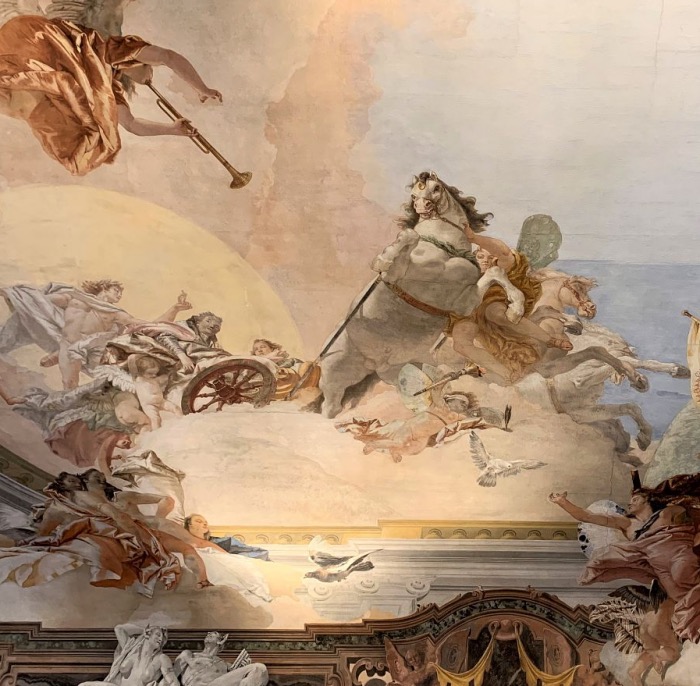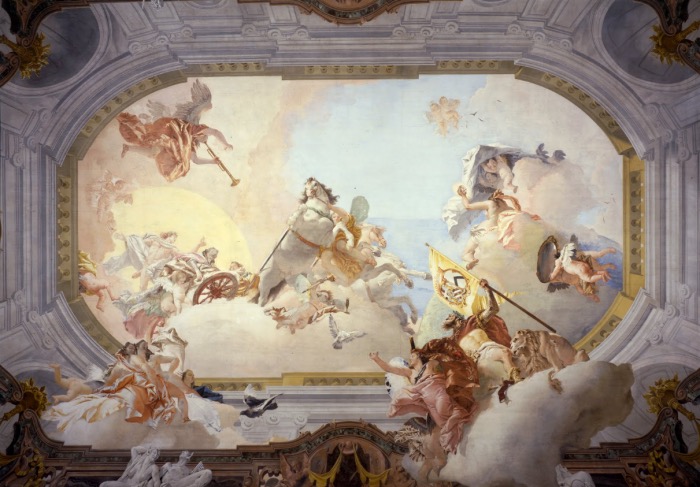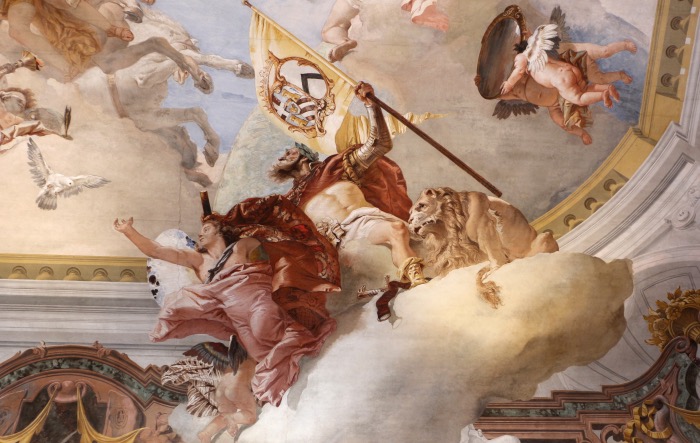
There is a stunning fresco in a museum in Venice, it is Tiepolo’s Wedding Allegory at Ca’ Rezzonico and it gives its name to the room in which it is located.
The work was created by Giambattista Tiepolo in collaboration with his son Giandomenico and Gerolamo Mengozzi, known as il Colonna, his trusted quadraturista, in 1757.
The commission for the fresco was prestigious.
In fact, the Rezzonico family contacted Tiepolo and entrusted him with this commission because Ludovico, nephew of Pope Clement XIII, was about to marry Faustina Savorgnan, from a wealthy family of Friulian origin.
Tiepolo had to celebrate the Rezzonico, who had a member of the Pope’s family and, with a new marriage just around the corner, could only see a bright future full of glory.
Tiepolo’s Wedding Allegory at Ca’ Rezzonico: Description and Meaning

This fresco is the last work in Venice before the artist’s departure for Madrid.
Tiepolo’s life and works are in fact characterised by a series of successes and travels throughout Europe to work on the great commissions that sovereigns, princes, cardinals and the most important families of the time entrusted him with.
DESCRIPTION OF TIEPOLO’S WEDDING ALLEGORY
Tiepolo depicts a shining sky opening up beyond a fake balustrade. Four grey horses can be seen pulling Apollo’s chariot on which the bride and groom are seated, while the sun god stands behind them.
Cupid, god of love, is blindfolded and advances amidst flights of doves and angels, premonitory figures of the bride and groom’s fortunate fate.
It is also impossible not to notice Fame blowing her trumpet to announce the event and the three Graces standing on a cloud just below Apollo’s chariot, together with Wisdom.
An old man with a beard holds the sceptre and flag with the coats of arms of the bride and groom’s families. At the man’s feet is also the lion, symbol of Venice.
ANALYSIS OF TIEPOLO’S WEDDING ALLEGORY
The sunlight that envelops the whole scene and the colours, all in soft tones, describe a fantastic scene with a fairy-tale flavour.
This is one of Giambattista Tiepolo’s first works in Venice before he moved to Madrid in 1762. It is his last work but also one of his greatest masterpieces, together with Neptune offering gifts to Venice, exhibited at the Doge’s Palace.
The central panel was executed entirely by Giambattista Tiepolo, with the speed that characterised his work. In this case, documents confirm that the artist needed only 12 days of work.
His son Giandomenico certainly took care of the four pairs of figures of satyrs and satires, which were painted in monochrome and placed on the cornices. Gerolamo Mengozzi, known as Colonna, devoted himself to the other figures.
CURIOSITIES ABOUT TIEPOLO’S WEDDING ALLEGORY AT CA’ REZZONICO
Tiepolo’s Wedding Allegory is one of the most fascinating works in Ca’ Rezzonico, which was once the residence of the Rezzonico family and is now home to the Museum of 18th century Venice.
It is an opulent celebration of marriage, rich in symbolism and allegories.
A curiosity about the work concerns the central figure of the fresco: the bride.
Many visitors wonder who the depicted woman really is. If it really is Faustina Savorgnan, the bride.
Actually, from some documents, it seems that the model used by the artist to create this character is not Faustina, nor is she a Venetian noblewoman. Instead, it seems to be a humble Venetian laundress named Angela.
The decision to use a woman of the people as a model for such an important representation reflected Tiepolo’s innovative approach, which sought to seek beauty in the everyday life of ordinary citizens.

Tiepolo’s Wedding Allegory is an extraordinary work that combines technical mastery with conceptual depth. It offers a fascinating window on 18th century Venice and bears witness to the artistic genius of one of the greatest painters of his time.


mix of church an pagan is no good-as modern ecumenism